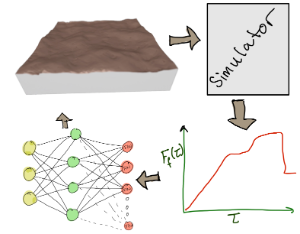Friction, the force resisting relative motion between solid surfaces in contact, is an important problem both in fundamental and applied physics. Being able to predict friction is crucial both in applications like object grasping robots, and in scientific problems like understanding earthquakes in the earth’s crust.
Frictional properties are generally sensitive to changes in surface structures, which leads to the idea of controlling friction by choosing particular surface structures. But how can we look for and evaluate surface structures?
We propose to use neural networks to establish mappings between surface configurations and resulting physical properties such as the maximum frictional force a surface can bear given some normal load. These neural networks will be used, along with with procedural surface structure generation methods inspired by computer game development to generate candidate surface structures with a prescribed frictional behavior. We will then set up a feedback-loop between the physics-based simulation and the machine-learning based surface generator to incrementally improve the ability of the machine learning algorithm to generate good surface structures.
In this project, you will learn how to integrate physics-based simulations and machine learning into a scientific workflow, with the goal of creating optimized surface structures. This process trains skills that are valuable both in a scientific setting and in industry.
The project may include collaborations with the Center for Advanced Computing and Simulations at University of Southern California.
Requirements
- MSc in physics, preferably in statistical or computational physics.
- Candidates with documented experience in scientific programming, simulations, and experience from machine learning will be prioritized.
Supervisors
Professor Anders Malthe-Sørenssen
Professor Morten Hjorth-Jensen
Call 1: Project start autumn 2021
This project is in call 1, starting autumn 2021. Read about how to apply
